I’ve noticed that specific words get thrown around a lot when talking about watercraft (PWC) that many people might not know.
Words like iBR, RIDE, ECO, etc. are foreign to new riders. What do they even mean?
This is why I’m creating this post to have one place to point to for such words that relate to PWCs.
This will also be a growing and changing list as manufacturers create new ones.
Jet Ski Vs. PWC Vs. Waverunner
Before I get too deep in the terms, I need to talk about the biggest ones of all… what we call them.
- Jet Ski = Kawasaki
- PWC = Sea-Doo
- Waverunner = Yamaha
The names reflect the manufacturer, it’s Kawasaki that owns the jet ski naming but is used to describe all of them. It’s like how Kleenex is used to describe tissues. This is called a “proprietary eponyms“.
There is no wrong way to say it, saying PWC or Waverunner will be understood as a jet ski. Even using the single word “jetski” is fine, too. I must point this out as I had many customers ask me about this.
While I’ll sprinkle a little bit of them all in all my posts, I’ll mostly stick to “Jet Ski,” as that is what most people know.
iBR – RIDE – KSRD
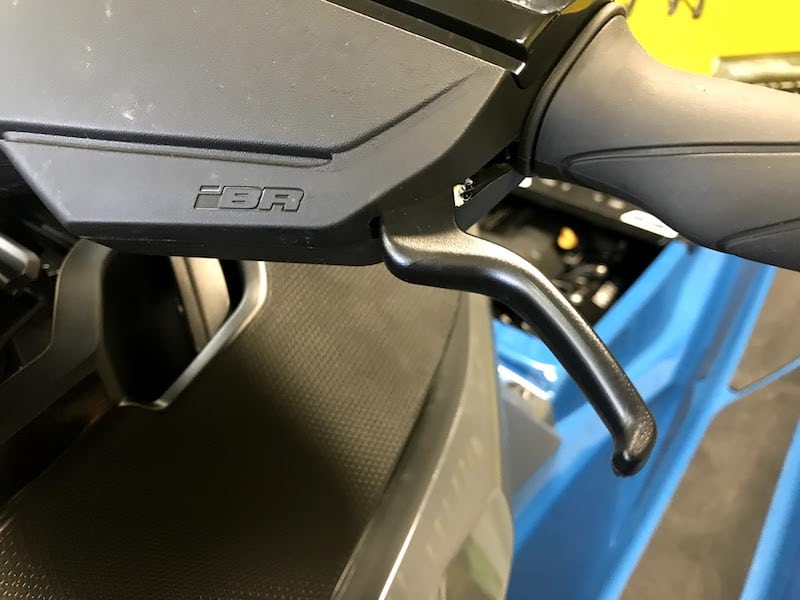
iBR, RIDE, and KSRD are essentially the same things – this is your forward, neutral, brakes and reverse of the jet ski.
While the idea for them is the same, they each have their nuances of operation.
iBR is a Sea-Doo product, RIDE is the Yamaha version, and KSRD is the Kawasaki version. The Yamaha RIDE system acts more like a dual throttle, one forward and the other for reverse. The Sea-Doo iBR acts more like a throttle on one side and a brake like on a motorcycle on the other. The Kawasaki KSRD uses a thumb brake instead of a finger throttle like the other two.
iBR, RIDE, and KSRD are the transmission of your jet ski, and I have a great article describing how it works here.
Direct Drive
A common misconception about jet skis is that people think they have a “real” transmission like a boat.
A jet ski uses a direct drive system.
What this means is that the engine is directly connected to the impeller. So if the engine is on, the impeller is spinning, and water is moving.
What controls forward and reverse is a bucket in the rear, as discussed under the iBR and RIDE section.
Since they are direct-drive, the engine must be off when boarding and unboarding a jet ski for safety reasons.
And from personal lessons I’ve learned, if your key or lanyard is old and stretched out, you need to replace it. I was riding a jet ski with a worn-out lanyard that stretched further than it was supposed to, and when I fell off, the engine did not shut off like it would if it was not stretched out. Since I was in the water and the jet ski upside down, I was not thinking, as many people would after falling off, and started to reach for the intake where the impeller was still spinning before I caught myself. So, you mustn’t use a worn-out lanyard because if the engine is on, the impeller is spinning and those impeller blades are dangerous!
Sea-Doo does have iDF, which is like a transmission, but not 100% what people would consider a transmission.
Impeller
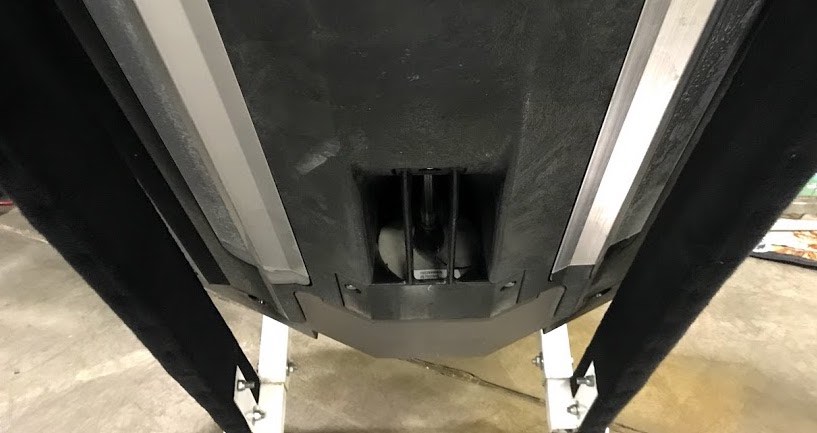
The impeller is the spinning blades that move you forward. The image above shows the impeller.
The jet ski impeller sucks in water like a vacuum and pushes the water out to move you forward.
The impeller is precision built, and any slight imperfections can make your jet ski run funny. The impeller is strong, but there are protections like a wear ring in place to keep it in good shape.
Wear Ring
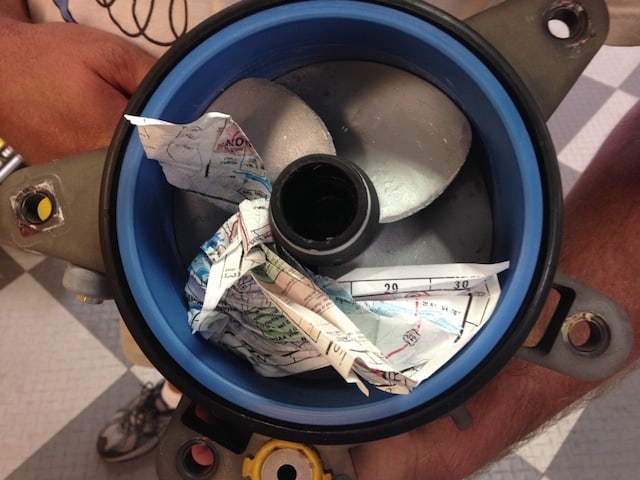
A wear ring goes around the impeller and is designed to protect the whole pump from significant damage.
The idea is that it’s cheaper and easier to replace a plastic or metal wear ring than it is to replace the entire housing if you suck up the wrong thing.
The most common thing to damage a wear ring is rocks or tree branches. The wear ring gets a groove cut into it and thus protects the pump as it gives way.
But the slightest of grooves in a wear ring can keep the jet ski from riding right. A damaged wear ring will often feel like the jet ski is slipping gears or not catching when you take off.
You can learn more about wear rings here.
Fiberglass
Fiberglass is the material that all boats are made of.
It’s smooth on the outside and is lightweight and very strong. Fiberglass also holds up to the elements better than metals, which is important for boats.
Most jet skis manufactured today use fiberglass and have been this way since the beginning. What is interesting is that manufacturers are playing with new materials that could replace fiberglass for jet skis.
The fiberglass we used decades ago is not the same as we do today. Older fiberglass was thicker, heavier, and messier compared to what we have today.
Yamaha is doing some amazing stuff with their Nanoxcel fiberglass. At the same time, Sea-Doo has been playing with new fiberglass methods and something unique called Polytec.
Polytec
Jet skis have been made of fiberglass for years, but in 2014, Sea-Doo came out with what they call Polytec.
Polytec is plastic meets fiberglass.
What makes plastic great is when you think of it like dinnerware. A glass plate (fiberGLASS) is strong and rigid but will shatter if dropped; a plastic plate will bounce instead.
Probably not the fairest comparison, but it does help to demonstrate the point. Plastic will have more give to it compared to fiberglass.
Going with plastic also cuts down on weight and cost, which is why the Sea-Doo Spark is a huge hit even to this day.
Sea-Doo is on Gen 2 of Polytec and has made it much thicker than when it first came out and added more reinforcements on the bigger Recreation models. Polytec did have its hiccups at the start, but it’s proving to be the future of jet skis or at least for Sea-Doo.
Here is video of a Sea-Doo Spark with the top deck removed so you can see the Polytec Hull.
Picking Colors?
When it comes to jet skis, they’re not like cars, where you can pick from a bunch of colors.
Most often, a PWC only comes in 1 color for that year’s model, with a select few models giving you 2 color options.
When the Sea-Doo Spark came out, it did have 5 color options, but Sea-Doo has since scaled it way down.
Color schemes also don’t always change every year; some manufacturers will keep the same colors for a few years.
When it comes to color on a jet ski, you want as bright and noticeable as possible. While darker colors look better, they blend in more when on the water.
Driving Modes
Driving modes can be one of the most confusing things about jet skis, as each manufacturer calls them something different.
Learning or Slo-Mode
Learning mode is a Sea-Doo thing and Slo-Mode is a Kawasaki thing, but both are the same idea.
It’s a mode for new riders to get used to the jet ski.
Yamaha has Low-RPM Mode, which is the same but could also be the ECO Mode that Sea-Doo has. As you can see, it gets complicated quickly.
What makes Learning Mode and Slo-Mode special is that both need a “key” to work and not a settings option. So if you had someone new to jet skis, they would be none the wiser and can’t change the setting once out in the water.
You could also adjust the learning mode from 32mph up to 50mph on select models using the normal key on some model Sea-Doos.
In 2020 Sea-Doo is moving away from the two key idea as it confused people. A lot of customers would program the learning key to normal so that they would have two fast keys. You would also get some people who did not realize they had the slow key on and wondered why the jet ski would not go full speed.
I would not be surprised to see this feature phased out and slower speed options like ECO and touring adopted more.
ECO or Low-RPM
ECO and Low-RPM Mode acts very similarly as a learning key where it would restrict top speed to about 45mph.
Sea-Doo ECO Mode goes one step further and makes the take-off power gradual.
Kawasaki ECO mode, for example, on the STX 160, alerts you when you have reach ECO area in the throttle.
Overall, these modes are to give you better gas mileage out of your jet ski. For a lot of people, 45mph is fast enough, and often never leave this mode. Keep in mind 45MPH on a little jet ski “feels like” 65mph in your car for new riders.
Cruise Control
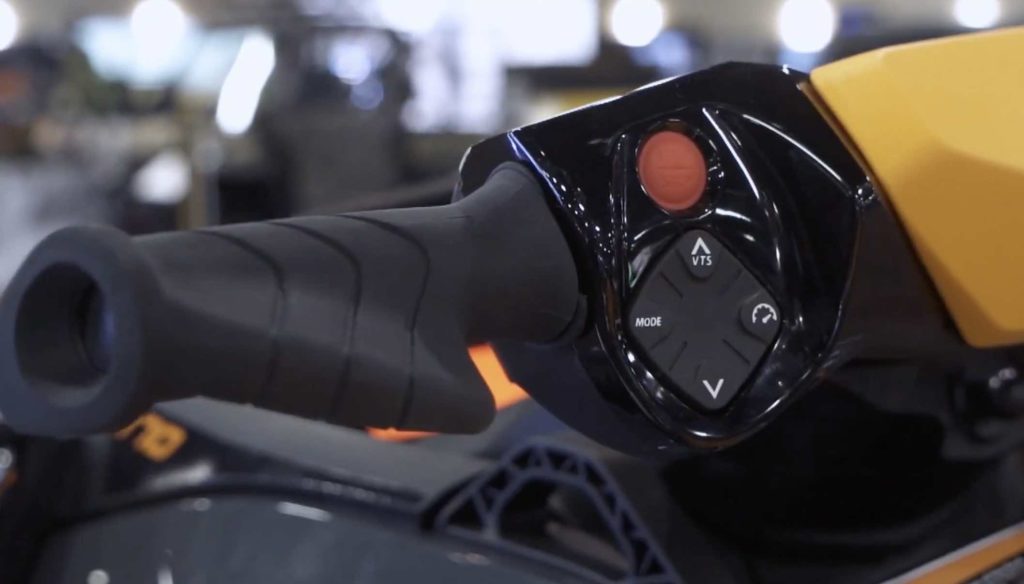
Also called Cruise Assist, Speed limiter Mode, Speed Regulator, and Speed Control Mode.
It works just like you think it does but is a little different from your car.
The difference with jet ski cruise control is that you need to hold the throttle in to keep moving.
You set the speed you want to cruise on a jet ski, but you must hold the throttle in, or it won’t work. I know this sounds like it defeats the whole point, but they do this for the “just in case” you fall off the watercraft, it won’t keep going. The good news is that the throttles are easy to hold all the way in, so it’s not a problem.
You also adjust the speeds you cruise at by pushing buttons on the handlebars.
Slow Speed, No Wake And 5MPH Mode
Slow speed mode, 5MPh mode, or No Wake Mode is cruise control but with a max speed of 5mph.
This is nice to have if you dock your jet ski at a marina with strict speed limits.
Many of the models that have Slow Speed Mode also allow you to adjust the speed from 1mph up to 5mph. I mention this as I know many marinas are super picky, and even if you do the speed limit of 5mph to the passer-by, it looks like you’re going faster than you are and can upset some. The idle speed of a jet ski is about 4mph, but that is still too fast for some marina and doing 1 or 2mph appeases them.
These slow speed modes also make docking easier, especially if you’re new to jet skis.
Tip: When at the docks or loading on a trailer, avoid using any throttle. Go slow, so slow it feels painful. Overdoing the throttle will only get you or someone hurt, trust me on this as I’ve been on the receiving end and have been hit by a boat that panic with the throttle.
Touring and Sport
All Sea-Doo have a Touring Mode and only a select few don’t have a Sport Mode.
Touring Mode is a slow take-off, but you gradually get to top speed.
Sport mode is full power take-off and top speed.
Sea-Doo defaults to touring mode every time you start it, and you must put it in Sport Mode if you want full power take-offs.
All Sea-Doo’s have Sport Mode except the 60HP Spark, which stays in touring mode all the time. The 90HP Spark gets Touring and Sport mode but no ECO because it’s already good on gas.
Categories
Rec-Lite – Entry-level jet skis and the cheapest options.
Recreation – A step above Rec-Lite but a lot more comfortable and less playful.
Performance – This is your racing style jet skis with the larger engines and racing features.
Touring – Also called Luxury are the best riding and come with the larger engine options. You also find the most bells and whistles in this category.
Tow Sports – Built for pulling tubes and skiers. They have features like ski pylons or come with tubes.
Sport Fishing – This is the newest category and only Sea-Doo has a model called the Fish Pro that fits. They’re Jet Skis built for fishing have coolers, fish finders, rod holders, and many more fishing accessories.
Closed Loop or Open Loop Cooling
All jet ski manufacturers except for Sea-Doo use an open-loop cooling system. This means they take in lake or ocean water to cool the engine and exhaust.
All Sea-Doo models since 4-strokes (2002 was the first 4-stroke, 2008 or later Sea-Doo were all 4-strokes) use a closed-loop cooling system.
A closed-loop cooling system is the same that your car uses. The engine circulates antifreeze through it and through a heat exchanger. In your car, the passing air cools the heat exchanger and thus cools the antifreeze to cool the engine. In a Sea-Doo, it’s the passing water that cools it instead of the air.
The biggest perk of a closed system is that it never takes in lake or ocean water, which is corrosive. A closed system also doesn’t have to worry about getting clogged because of a leaf got stuck in the intake of the cooling system.
But an open system is simpler and will always run a little cooler than a closed system. Taking water from the lake or ocean will always be cooler than using a heat exchanger to dissipate heat.
Each has its trade-offs and perks.
One thing of note! While Sea-Doo does use a closed-loop cooling system on its engine, the exhaust and intercooler still take in water to cool those.
I’ve written an article that goes over more of the closed loop vs. open loop cooling system debate here.
iDF
iDF is a new feature for a few Sea-Doo models in 2021.
iDF acts similar to a transmission but is different from iBR.
The primary purpose is to get debris unstuck from the intake of the pump. Debris like seaweed and trash that may get stuck at the intake. It will not help much for ropes or rocks that get stuck.
You can learn more about iDF from here.
Trim or VTS
Just like boats, jet skis have a trimming system option.
Sea-Doo often uses the words VTS which means “variable trim system.”
This raises and lowers the nose of the watercraft, which helps with different riding conditions, racing, tow sports, and many more things.
The Sea-Doo Spark TRIXX has an extended trim system that allows you to do “wheelies” on the water.
All the jet skis you get today will have an electric trim while older models had a manual trim on the handlebars. A few models had a manual trim, but it was on the rear above the pump, which was very awkward to get to.
DESS
DESS is a digital encrypted security system.
This is a Sea-Doo thing as they use a lanyard as a key that only unlocks your PWC.
Yamaha uses a fob like your car or a PIN code. Kawasaki uses a key fob that you plug into the jet ski and is not apart of the lanyard like what Sea-Doo does.
The DESS lanyard key today use RF tech and a magnet. The magnet lets the machine know there is a key and to turn on the radios to read the RF signal from the key. Older Sea-Doo keys used a magnet and physical metal connections. The key itself stores a series of numbers, and the dealership has a computer that tells the machine to allow this key when programming.
If you lose your Sea-Doo key, you will need to take it to the dealership to get reprogrammed as the dealer needs the whole machine and a new key to program it. You can learn more about this here.
Footwell
The Footwell is where your feet rest when on the jet ski.
It’s important to talk about it as the padding and features of this area make a jet ski unique.
Some performance models have angled foot risers to better lock you in the jet ski when taking sharp turns.
The footwells can have mats that give you grip and is important to pay attention to as you’ll be jumping around in the water. Some mats feel better on the feet while others work better for water shoes.
Also, footwells hold water, and Yamaha is the only manufacturer with footwell drains, which is a very smart idea.
Palm Grips
Sea-Doo has a few models that have Palm Grips.
It’s the rubber ends at the handlebar, but these grips are not rounded like you see on a motorcycle and instead have palm rest.
This is more ergonomic and puts less stress on your wrist and arm while you ride. It’s a great idea but not loved by racers and get in the way for them. So you’ll see some models without these grips.
If you do long trips or don’t do any racing on your jet ski, the Palm Grips are a must.
Reboarding Step or Ladder
A reboarding step, or also called a ladder, is a simple drop-down bar or single step that helps you get back on your jet ski from the water.
Not every jet ski has one, but if you ask me, they should.
Even if you’re a very fit person, balancing and getting back on a jet ski without a ladder is hard. You’re waterlogged, and the water wants to keep you in the water. Not only that, but you’ll need to balance too.
Let’s just say, YouTube has some funny videos proving that a ladder or a step is a must-have.
Ski Pylon
A ski pylon is an accessory that is only found on Sea-Doo models and comes standard on the WAKE models.
The ski pylon raises the tow point higher for the person being pulled and gives the spotter something to hold on to.
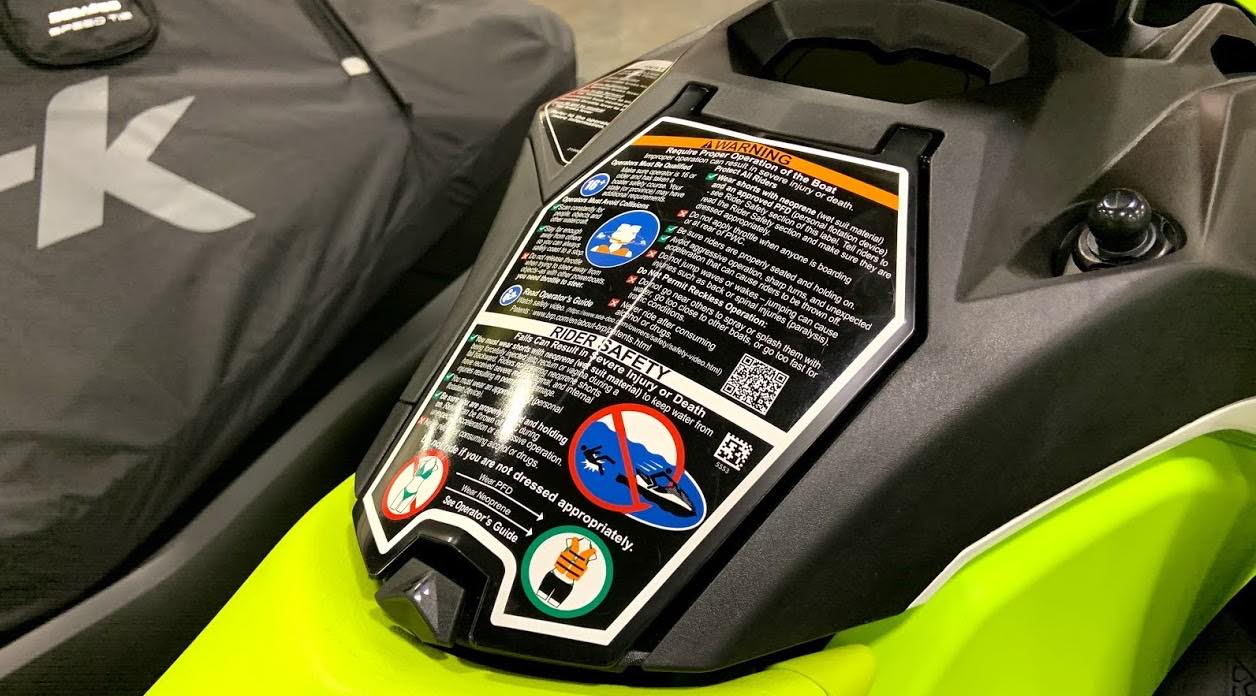
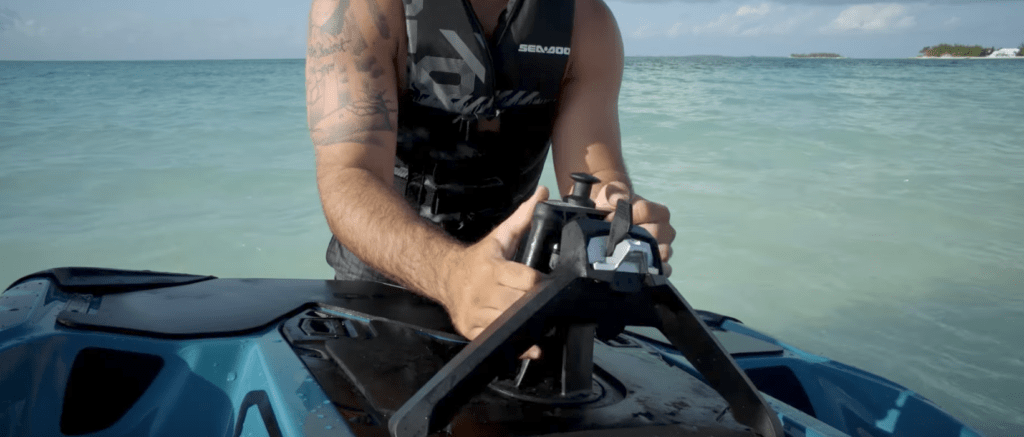
Steven,
I have two questions . . .
1. Which anchor do you recommend for a 2014 Sea Doo GTI?
Mainly for sandy/muddy areas close to shore.
The sand anchor might be messy & too much trouble.
I ‘m not sure if the 4-prong is strong enough. ?
What about the mushroom anchor, & how many pounds?
2. Can I leave my lanyard attached to my lifejacket WHILE I swim, or does it need to stay dry?
Will it hurt anything if it gets wet while we swim?
I tend to stay in the water a long time before reboarding.
THANK YOU!!!
1. I suggest looking at the screw anchor. https://www.steveninsales.com/lets-talk-jet-ski-anchors-best-ones-get/#Jet_Ski_Screw_Anchors
2. It’s fine to get your lanyard wet. The only real problem that you want to avoid when it comes to lanyards is stretching it out too much, it’s a safety thing. If the lanyard bungee is flaking off or really stretched out you want to get a new lanyard. The Sea-Doo lanyard floats too so it may get in your way when swimming so I usually take it off when I’m not on the jet ski.